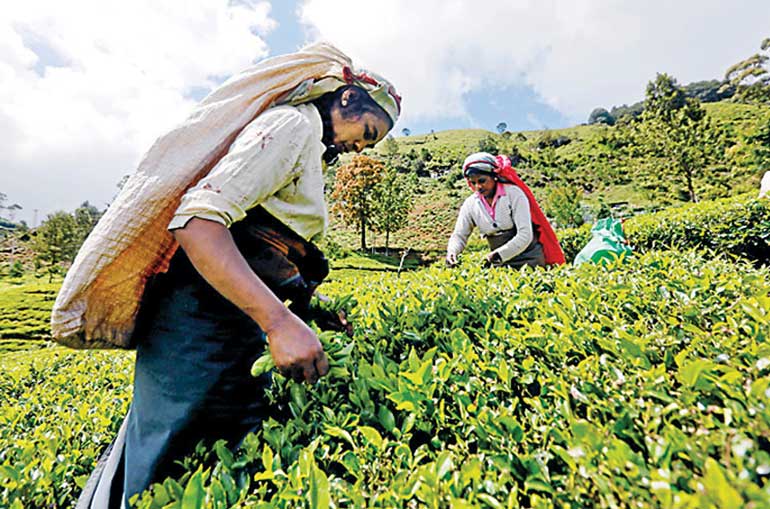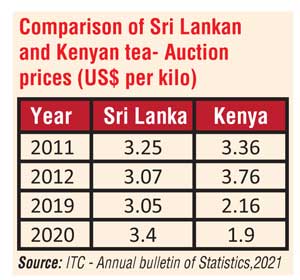Tuesday Dec 02, 2025
Tuesday Dec 02, 2025
Tuesday, 4 January 2022 02:25 - - {{hitsCtrl.values.hits}}

The tea industry has recorded an excellent performance in the just concluded 2021, despite the many challenges faced by the stakeholders, according to the Sri Lanka Tea Board.
Chairman Jayampathy Molligoda, citing provisional numbers, yesterday said that the total export revenue from tea in 2021 was Rs. 264 billion (approximately $ 1.32 billion). The total export quantity was 288 million kilos.
In 2020, export revenue was Rs. 230 billion ($ 1.21 billion) and export quantity was 266 million kilos. 
“It is significant to mention the average fob price at customs, which was Rs. 867 per kilo in 2020 has further increased to Rs. 915.97 per kilo, whereas in 2019 it was only Rs. 823 per kilo of tea exported,” Molligoda said. The sales and tea production statistics for the month of December are yet to be finalised, however some 296 million kilos have been sold and closer to 300 million kilos of tea production has been achieved for the full year. Last year tea production was only 279 million kilos.
“The negative side is that our tea estate productivity has been declining over a period of time. In 2000, the production was 305 million kilos and rose to 328 million in 2010. The highest crop of 338 million kilos was in 2013 and since then there has been a gradual decline amounting to 2.6% CAGR,” the SLTB Chairman revealed.
According to Molligoda, the cost of production has been increasing due to many factors including low productivity, both land and labour, high overheads and adverse impact of climate change and COVID-19.
He said that Kenyan tea production (the main competitor for Sri Lankan teas) has been increasing rapidly and that Sri Lankan tea production has been declining over the last 10-15 years.
“This is due to lack of tea replanting and infilling undertaken and the producers’ inability to address climate change effects and other factors, as there has been a gradual erosion of soil and land degradation, despite application of fertiliser,” Molligoda added.
Kenyan tea auction price in US Dollars is lower compared to Sri Lanka and their growers are getting lower tea prices, whereas in Sri Lanka, small holders are getting a reasonable price and it is being regulated under Tea Control Act No. 51 of 1957.
SLTB said the Ceylon Tea was one of the most expensive teas in the global market – gram to gram – and as a result, there is a tipping point in the tea pricing structure for Sri Lankan tea exporters and marketers to be competitive in the global marketplace. In view of the above, an ‘integrated productivity and quality strategy’ is one of the key focus areas for the producers to reduce costs per kilo of made tea to enable the exporters and marketing teams to capitalise on Ceylon Tea ‘brand equity’.
In the circumstances, it is important that the producers adopt an integrated balanced nutrient management system with more and more mineral and organic inputs to be applied, in order to improve the soil quality to achieve environmental and economic sustainability and focus on the social well-being of the workers and small holders/growers rather than looking for short term gains.
“The overall performance is satisfactory. However, achieving any further increases of higher prices for Ceylon Tea has become a challenge, because Kenyan and Indian auction prices are much lower than Colombo auction prices,” Molligoda said.
“Nevertheless, we need to focus more on the front end of the value chain by implementing the already approved promotional activities under the ‘Ceylon Tea global campaign’ coupled with aggressive marketing strategy formulated with the support of all the industry stakeholders’ participation.”
In that context, the SLTB Chief said the brand story that of Ceylon tea being the cleanest tea in the world has to be reinforced through the maintenance of minimal levels of chemical residue and demonstrating sustainable credentials, including the purity and wellness factor of Ceylon Tea.
The SLTB Chairman also extended his gratitude to all the stakeholders for their dedication, commitment and their relative performance. “It’s a great achievement under a difficult and challenging environment,” Molligoda added.